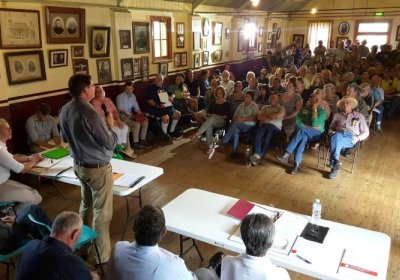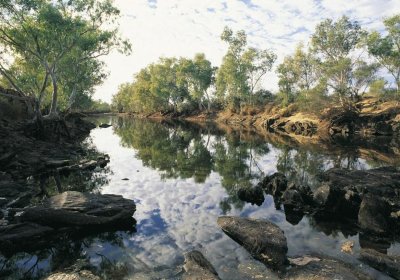Armed with the findings of the Nuclear Fuel Cycle Royal Commission, South Australian Labor Premier Jay Weatherill is pressing ahead with plans to import as much as a third of the world's high-level nuclear reactor waste and store it in the state's outback.
There are compelling reasons to reject it. The project, it now emerges, could go ahead only over resistance from Indigenous traditional landowners, some of whom took part in the Lizard Bites Back convergence in early July.
Nuclear energy
As a sagging economy cruelled their electoral chances, right-wing parliamentarians and power-brokers in the South Australian Labor Party decided in late 2014 that it was time to ditch a once fiercely-defended point of policy. The party's remaining opposition to the nuclear fuel cycle would have to go.
Labor Premier Jay Weatherill soon came on board, and by March last year the state's Nuclear Fuel Cycle Royal Commission was under way.
"Remembering Fukushima: Resisting nuclear waste dumps!" was the title of a public forum held in Redfern on March 3. About 40 people heard a panel of speakers mark five years since the Fukushima tsumani and nuclear disaster in March 2011 and outline the growing opposition movement to federal government plans for a nuclear waste dump in rural Australia.
"The nuclear industry has no place in a safe and sustainable future. Five years since the Fukushima disaster, it is time to break the nuclear chain," forum publicity stated. The forum was organised by Uranium Free NSW.
The front page headline “Trash and treasure” on the February 16 edition of South Australia's only daily newspaper, The Advertiser, welcomed the recommendation from the Nuclear Fuel Cycle Royal Commission for a nuclear waste dump in outback SA. The commission had cost a massive tax-payer funded $8 million.
After two decades of failing to secure a nuclear waste dump site in South Australia and the Northern Territory through a top down approach, early last year the federal government initiated a voluntary nomination process calling on landholders to put forward their land for assessment.
A shortlist of six was released after 28 sites were nominated around Australia: Hill End in NSW; Omanama in Queensland; Hale in the Northern Territory; Cortlinye and Pinkawillinie in the Kimba region of South Australia; and Barndioota station in the Flinders Ranges, South Australia.
The appointment of nuclear power advocate Alan Finkel as Australia's next Chief Scientist led to speculation that the federal government might be softening up Australians for the introduction of nuclear power.
But that speculation is likely misplaced. Finkel is not the first Chief Scientist to support nuclear power. It goes with the turf: boys like toys and Chief Scientists like nuclear power. Finkel's comments were actually quite nuanced and at least as supportive of renewables as nuclear power.
The radioactive exposure tour — the RadTour — organised by Friends of the Earth and the Anti-uranium and Clean Energy collective (ACE), was on again this year from June 27 till July 8. Twenty-five people travelled from Melbourne through south and western NSW then onto South Australia.
Green Left Weekly's Rachel Evans caught up with the RadTour at Lucas Heights and spoke to Dr Jim Green from Friends of the Earth.
* * *
How has the campaign to make Australia nuclear free been going?
 British submariner William McNeilly went on the run after he released confidential information about Britain's Trident nuclear weapons program on May 12. He was detained by police after returning to Scotland on May 18.
McNeilly had been in hiding after he wrote and released an 18 page document highlighting a “disaster waiting to happen”. The British defence ministry said he was being held in a secure military base.
British submariner William McNeilly went on the run after he released confidential information about Britain's Trident nuclear weapons program on May 12. He was detained by police after returning to Scotland on May 18.
McNeilly had been in hiding after he wrote and released an 18 page document highlighting a “disaster waiting to happen”. The British defence ministry said he was being held in a secure military base.
This month, the Radioactive Exposure (RAD) Tour will travel almost 5000 kilometres through three states exposing the reality of radioactive racism, the impacts of uranium mining, radioactive waste and nuclear expansion.
The Rad Tour is a wild ride. It bundles activists, campaigners and anyone with an interest in learning about the nuclear industry into buses to travel dusty desert roads and long highways on a journey through Australia’s nuclear landscape.
Ten years ago, the uranium price was on an upward swing. South Australians were dazzled by the prospect of becoming the 'Saudi Arabia of the South' because of the state's large uranium deposits and the prospect of a global nuclear power renaissance.
Those comparisons didn't stand up to a moment's scrutiny — Australia would need to supply global uranium demand 31 times over to match Saudi oil revenue.
The Environmental Protection Authority (EPA) gave approval to a uranium mine at Kintyre in Western Australia on July 28. The mine is about 260 kilometres north-east of Newman in the east Pilbara in an area that was excised from the Karlamilyi (Rudall River) National Park to allow mining in 1994.
Because it is illegal to export uranium from WA, trucks carrying the uranium oxide concentrate — otherwise known as yellowcake — will have to travel 4600 kilometres from the Kintyre mine to Port Adelaide.
- Previous page
- Page 2
- Next page










